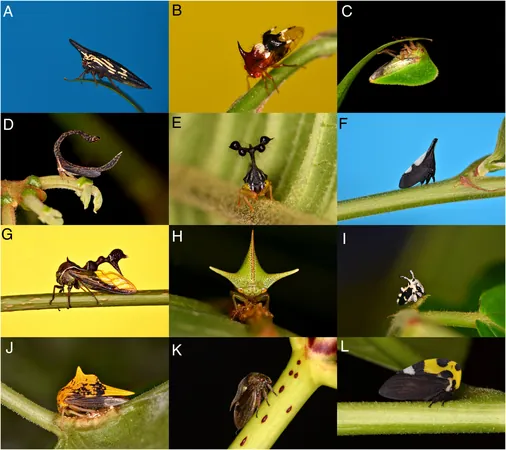
Unveiling the Mysteries of Treehoppers: Nature's Electric Cloak and Warning System!
2025-07-23
Author: Wei Ling
Nature's Marvel: Treehoppers and Their Bizarre Shelters
In the wild world of evolution, nature constantly surprises us with remarkable adaptations that boost survival rates. From the super-hearing of the Greater Wax Moth to the astonishing polarized vision of mantis shrimp, sensory evolution has produced an incredible range of techniques. One such adaptation, electroreception—the ability to sense faint electrical fields—is predominantly found in aquatic creatures, yet it extends its reach to some fascinating insects.
Treehoppers: The Electroreceptive Oddities
A groundbreaking study has now unveiled the treehopper as a new contender in the world of electroreceptive insects, highlighting how its anatomy has evolved to optimize this extraordinary ability. Closely related to cicadas and leafhoppers, treehoppers are easily recognized by their strikingly bizarre pronotum, a shield-like structure found at the thorax just below their heads. Depending on the species, this feature can take on forms resembling horns, spikes, or even plant-like structures, playing a crucial role in their survival.
The Colorful Mystery Behind Their Unique Features
While many insects utilize their unusual appearances for camouflage to evade predators, the treehopper’s distinct pronotum can often be bright and unapologetically patterned, sparking curiosity among scientists about the true purpose of this striking feature. According to the researchers, the evolutionary reasons behind these eye-catching morphological traits had, until now, remained largely puzzling.
Breaking New Ground: Investigating Electrostatic Sensitivity
To delve deeper, scientists proposed that the peculiar shape of the treehopper’s pronotum might interact with electrostatic fields similarly to the antennae of bees and other insects. To test this hypothesis, they measured electric charges in the treehopper’s natural surroundings in Costa Rica, collecting data from 151 treehoppers, several species of wasps, and bees as these insects moved through a custom ring electrode setup.
Shocking Discoveries: Strong Electric Fields Revealed!
The findings were astonishing. Close encounters between treehoppers and predatory wasps revealed detectable electric fields, with the strongest readings occurring around the protruding parts of the treehopper's pronotum—50 times more intense than typical background levels! This discovery suggests that treehoppers have evolved to not only sense electric fields but also possess a form of electrical invisibility cloak, reducing the risk of detection by electroreceptive predators.
Connection Between Form and Function Unraveled
The study highlights a remarkable connection between form and function in these extraordinary insects, illustrating how the eye-catching adaptations in treehoppers may serve crucial roles in their survival strategies. This breakthrough challenges previous notions of electroreception, once thought exclusive to aquatic animals and recently confirmed in mammals like platypuses and echidnas.
A New Chapter in the Study of Electroreception!
As we continue to explore the fascinating world of electroreceptive abilities in the animal kingdom, the revelations about treehoppers remind us that nature’s innovations are both endless and awe-inspiring. The colorful adaptations and unique survival strategies of these remarkable insects invite further investigation, pushing the boundaries of our understanding of evolution.




 Brasil (PT)
Brasil (PT)
 Canada (EN)
Canada (EN)
 Chile (ES)
Chile (ES)
 Česko (CS)
Česko (CS)
 대한민국 (KO)
대한민국 (KO)
 España (ES)
España (ES)
 France (FR)
France (FR)
 Hong Kong (EN)
Hong Kong (EN)
 Italia (IT)
Italia (IT)
 日本 (JA)
日本 (JA)
 Magyarország (HU)
Magyarország (HU)
 Norge (NO)
Norge (NO)
 Polska (PL)
Polska (PL)
 Schweiz (DE)
Schweiz (DE)
 Singapore (EN)
Singapore (EN)
 Sverige (SV)
Sverige (SV)
 Suomi (FI)
Suomi (FI)
 Türkiye (TR)
Türkiye (TR)
 الإمارات العربية المتحدة (AR)
الإمارات العربية المتحدة (AR)